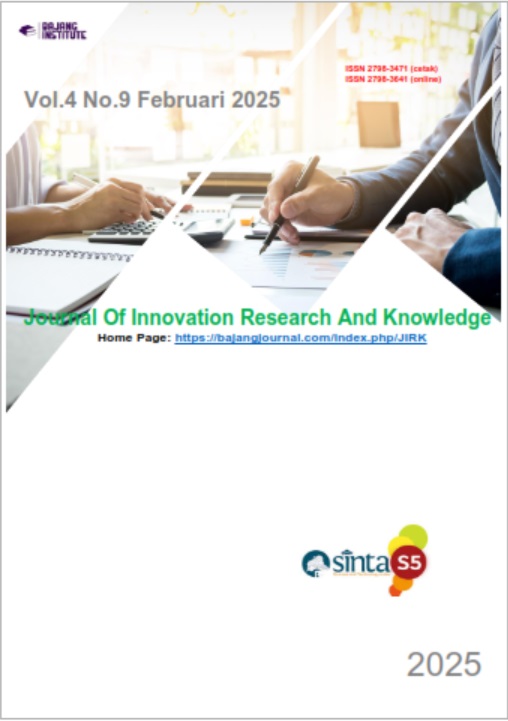EFEKTIVITAS PENGGUNAAN ANTIBIOTIKA CEFEPIME DIBANDINGKAN DENGAN CEFTRIAXONE PADA PASIEN FIBRILE NEUTROPENIA ACUTE MYLOID LEUKIMIA (AML) DI RSUP Dr. KARIADI SEMARANG
DOI:
https://doi.org/10.53625/jirk.v4i9.9719Keywords:
Fibrile Neutropenia, Neutropenia, AML, Leukemia, Cefepime, Ceftriaxone,, Effectiveness, ChemotherapyAbstract
Leukemia or blood cancer is a diverse neoplastic disease, characterized by abnormal production (malignant transformation) of blood forming cells in the bone marrow and lymphoid tissue. Treatment of leukemia patients using chemotherapy. One of the side effects is Fibrile Neutropenia. Handling efforts have been done but have not provided maximum effect. Therefore there is a need for other treatments such as the use of antibiotic monotherapy. The purpose of this study was to determine the pattern of antibiotic administration in patients with AML who were diagnosed with neutropenia after induction chemotherapy and to know the effectiveness of cefepim antibiotics and ceftriaxone for treating neutropenic fever in AML after induction chemotherapy at RSUP Dr. Kariadi Semarang.
The research method used was a retrospective cohort study based on primary data from the patient's medical record. The study was conducted by tracing data on medical records of patients at RSUP Dr. Kariadi Semarang analysis can be carried out using independent t test.
The results showed 47 fibrile neutropenia patients who met the inclusion criteria. The mortality rate of cefepime antibiotics was 17.39% and ceftriaxone was 16.67%. The life expectancy of cefepime antibiotics was 82.61% and ceftriaxone was 83.33%. The antibiotic culture showed that 16.67% was resistant to cefepime antibiotic and 43.48% was resistant to ceftriaxone. 56.52% are still sensitive to Ceftriaxon and 83.33% are still sensitive to Cefepime. The ANC level has a significant difference (P-value of < 0.05), while in the analysis of decreased body temperature There is also a significant difference (P-value of < 0.05).
From these results it can be concluded that cefepime antibiotics are more effective than ceftriaxone antibiotics in patients with AML fibrile neutripenia.
References
Adrieanta, Windiastuti E, Handryastuti S. Etiologi demam neutropenia pada anak dengan keganasan dan penggunaan skor klasifikasi Rondinelli. Sari Pediatri 2014;16:229-35.
Al-ahwal, M.S., Al Sayws, F., Johar, I., 2005, Febrile Neutropenia Comparasion between solid tumors and hematological malignancies.Saudi Med J; 4(3): 4-7
BaktaI M. Hematologi klinik ringkas. Jakarta: EGC; 2003; 117:120-31.
Belson et al. 2007, ‘Risk Factors for Acute Leukimia in Children: A Revew’, Enviromental Health Perspectives, vol. 115, no. 1, 138-143.
Castagnola E, Fontana V, Caviglia I, Caruso S, Faraci M, Fioredda F, dkk. A prospective study on the epidemiology of febrile episodes during cshemotherapy-induced neutropenia in children with cancer or after hemopoietic stem cell transplantation. Clin Infect Dis 2007;45:1296-304
Cindy et al, (2017) tentang ACUTE MYELOID LEUKAEMIA. https://www.google.com/url?sa=t&source=web&rct=j&url=https://simdos.unud.ac.id/uploads/file_penelitian_1_dir/ae97d96d7b3a36c778ca436020f67ca5.pdf&ved=2ahUKEwjPzp2T6dniAhW84XMBHS22Dc8QFjAAegQIARAB&usg=AOvVaw3f5j7E6V_iMbQ0__Re36n3 Diakses pada tanggal 4 Mei 2019
Crawford, J., Dale, D. and Lyman, G., 2004. CrawfordJ, Dale DC, Lyman GH. Chemotheraphyinduced neutropenia: risk, concequences, and new directions for its management. Cencer. (2004) 100(9), pp.1993-1994.
Departemen Kesehatan RI. Obesitas dan kurang aktivitas fisik menyumbang 30% kanker. 2009. Tersedia dari: URL: HYPERLINK http://www. indonesia.go.id
Departemen Kesehatan RI. Obesitas dan kurang aktivitas fisik menyumbang
Desen W. Buku ajar onkologi klinis. Edisi ke-2. Jakarta: Balai Penerbit FKUI; 2008.hlm.547-98.
Hakim H, Flynn PM, Knapp KM, Srivastava DK, Gaur AH. Etiology and clinical course of febrile neutropenia in children with cancer. J Pediatr Hematol Oncol 2009;31:623-9.
Howlader N, Noone AM, Krapcho M, Neyman N, Aminou R, Waldron W, et al. SEER Cancer statistics review 1975-2008, National Cancer Institute. Bethesda MD. 2011. Tersedia dari: URL: HYPERLINK http://seer.cancer.gov/csr/1975_2008/
Hughes WT, Armstrong D, Bodey GP, Bow EJ, Brown AE, Calandra T, dkk. 2002 guidelines for the use of antimicrobial agents in neutropenic patients with cancer. Clin Infect Dis 2002;34:730–51
Lowenberg B, Cornelissen JJ, Sonneveld P. Leukemia akut dan kronik. Yogyakarta: Oncology; 1999.hlm.641-8.
Marlinda. Gambaran hematologi leukemia nonlimfoblastik akut di RSUP M Djamil Padang periode 1991-1998. Padang: Fakultas Kedokteran Universitas Andalas; 1999.
Permono, Bambang dkk. 2005. Buku Ajar Hematologi Onkologi Anak. Ikatan Dokter Anak Indonesia













